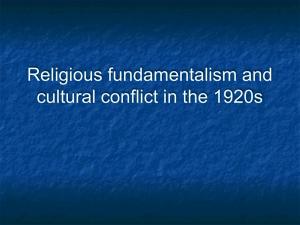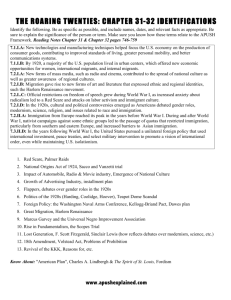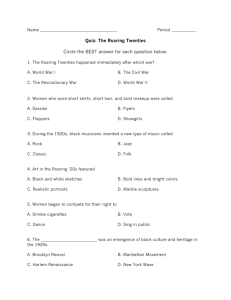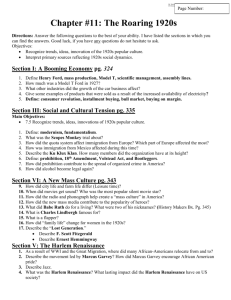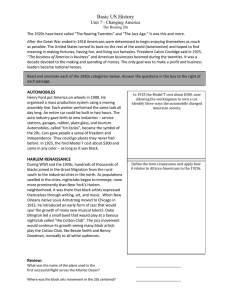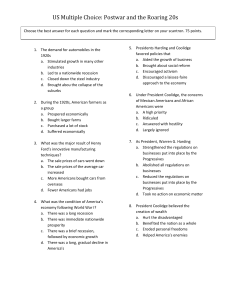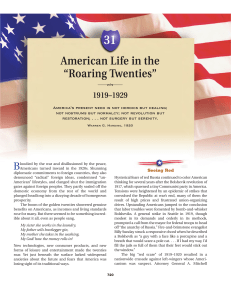APUSH Chapter 23 Key Terms & Essay Prompts: Roaring Twenties
advertisement
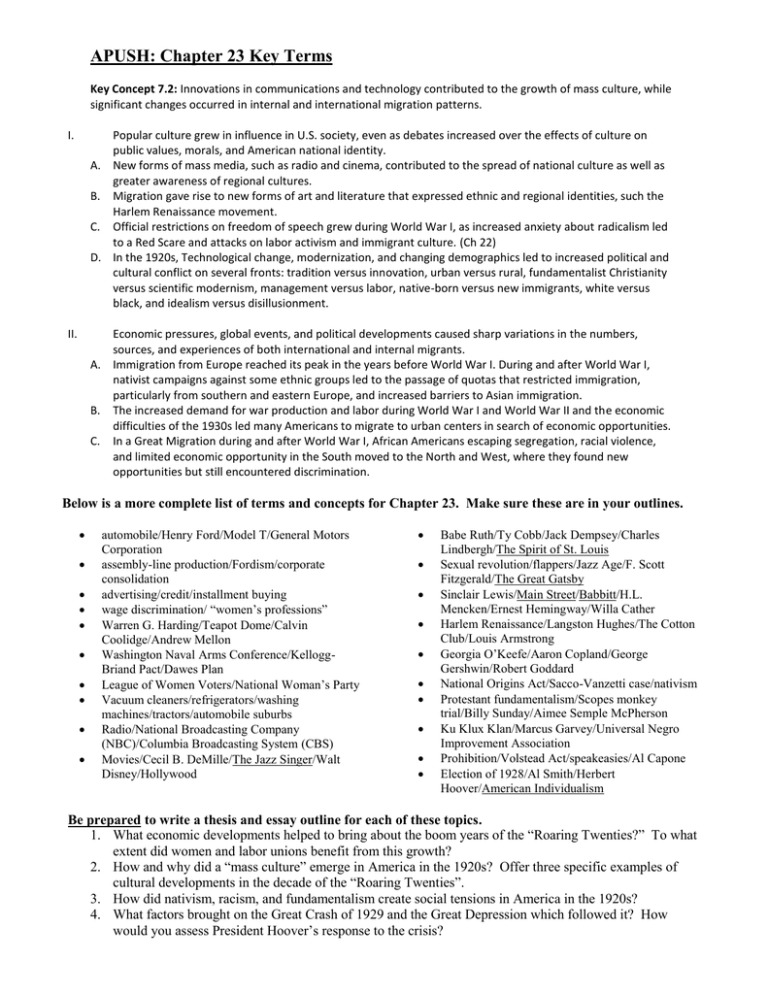
APUSH: Chapter 23 Key Terms Key Concept 7.2: Innovations in communications and technology contributed to the growth of mass culture, while significant changes occurred in internal and international migration patterns. I. Popular culture grew in influence in U.S. society, even as debates increased over the effects of culture on public values, morals, and American national identity. A. New forms of mass media, such as radio and cinema, contributed to the spread of national culture as well as greater awareness of regional cultures. B. Migration gave rise to new forms of art and literature that expressed ethnic and regional identities, such the Harlem Renaissance movement. C. Official restrictions on freedom of speech grew during World War I, as increased anxiety about radicalism led to a Red Scare and attacks on labor activism and immigrant culture. (Ch 22) D. In the 1920s, Technological change, modernization, and changing demographics led to increased political and cultural conflict on several fronts: tradition versus innovation, urban versus rural, fundamentalist Christianity versus scientific modernism, management versus labor, native-born versus new immigrants, white versus black, and idealism versus disillusionment. II. Economic pressures, global events, and political developments caused sharp variations in the numbers, sources, and experiences of both international and internal migrants. A. Immigration from Europe reached its peak in the years before World War I. During and after World War I, nativist campaigns against some ethnic groups led to the passage of quotas that restricted immigration, particularly from southern and eastern Europe, and increased barriers to Asian immigration. B. The increased demand for war production and labor during World War I and World War II and the economic difficulties of the 1930s led many Americans to migrate to urban centers in search of economic opportunities. C. In a Great Migration during and after World War I, African Americans escaping segregation, racial violence, and limited economic opportunity in the South moved to the North and West, where they found new opportunities but still encountered discrimination. Below is a more complete list of terms and concepts for Chapter 23. Make sure these are in your outlines. automobile/Henry Ford/Model T/General Motors Corporation assembly-line production/Fordism/corporate consolidation advertising/credit/installment buying wage discrimination/ “women’s professions” Warren G. Harding/Teapot Dome/Calvin Coolidge/Andrew Mellon Washington Naval Arms Conference/KelloggBriand Pact/Dawes Plan League of Women Voters/National Woman’s Party Vacuum cleaners/refrigerators/washing machines/tractors/automobile suburbs Radio/National Broadcasting Company (NBC)/Columbia Broadcasting System (CBS) Movies/Cecil B. DeMille/The Jazz Singer/Walt Disney/Hollywood Babe Ruth/Ty Cobb/Jack Dempsey/Charles Lindbergh/The Spirit of St. Louis Sexual revolution/flappers/Jazz Age/F. Scott Fitzgerald/The Great Gatsby Sinclair Lewis/Main Street/Babbitt/H.L. Mencken/Ernest Hemingway/Willa Cather Harlem Renaissance/Langston Hughes/The Cotton Club/Louis Armstrong Georgia O’Keefe/Aaron Copland/George Gershwin/Robert Goddard National Origins Act/Sacco-Vanzetti case/nativism Protestant fundamentalism/Scopes monkey trial/Billy Sunday/Aimee Semple McPherson Ku Klux Klan/Marcus Garvey/Universal Negro Improvement Association Prohibition/Volstead Act/speakeasies/Al Capone Election of 1928/Al Smith/Herbert Hoover/American Individualism Be prepared to write a thesis and essay outline for each of these topics. 1. What economic developments helped to bring about the boom years of the “Roaring Twenties?” To what extent did women and labor unions benefit from this growth? 2. How and why did a “mass culture” emerge in America in the 1920s? Offer three specific examples of cultural developments in the decade of the “Roaring Twenties”. 3. How did nativism, racism, and fundamentalism create social tensions in America in the 1920s? 4. What factors brought on the Great Crash of 1929 and the Great Depression which followed it? How would you assess President Hoover’s response to the crisis?
